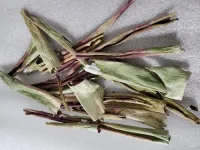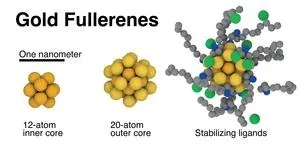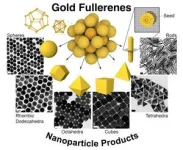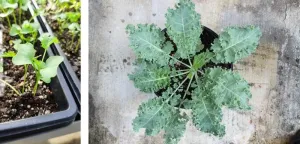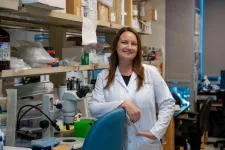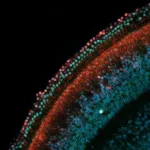(Press-News.org) SAN FRANCISCO, Aug. 15, 2023 — Aloe barbadensis, commonly known as aloe vera, has been used for thousands of years to treat skin ailments, promote digestive health and heal wounds. But while aloe vera gel is in high demand, the peels are thrown away as agricultural waste. Today, scientists report that these peels, or rinds, can ward off bugs, acting as a natural insecticide. They have identified several bioactive compounds in extracts from the peels that deter insects from feasting on crops.
The researchers will present their results at the fall meeting of the American Chemical Society (ACS). ACS Fall 2023 is a hybrid meeting being held virtually and in-person Aug. 13–17, and features about 12,000 presentations on a wide range of science topics.
A video on the research is available at www.acs.org/AloePeel.
“It’s likely that millions of tons of aloe peels are disposed of globally every year,” says Debasish Bandyopadhyay, Ph.D., the project’s principal investigator. “We wanted to find a way to add value and make them useful.”
Bandyopadhyay first became interested in the potential use of aloe rinds as an insecticide when he and a colleague visited a local aloe vera production center, where he noticed that insects had left the aloe leaves alone, despite attacking the leaves of other plants. He asked the CEO of the company if he could take the rinds back to his lab — a request that confused the CEO, who initially tried to send Bandyopadhyay home with samples of the company’s products instead.
Some home gardeners have begun to use aloe gel as an ingredient in a natural pesticide mixture, along with onions and garlic, but these recipes don’t always include the peels. And currently, on a larger, industrial scale, aloe peels are treated as agricultural waste and largely used to create biomass, which can help improve soil quality at aloe farms. The main downside of this approach is that rotting agricultural waste can release methane and other greenhouse gases into the atmosphere, contributing to global climate change.
So Bandyopadhyay set out to explore the possibility of recycling the peels to develop a natural pesticide that, on its own, could help farmers in areas where insects can be a major threat, such as regions of Africa, the tropical and subtropical regions of the Americas, and the maize and millet fields in India. The new application as a pesticide could also provide an environmentally friendly alternative for disposing of the peels and create additional revenue streams for aloe vera producers. “The goal is to recycle this waste in a meaningful way while making aloe production greener and more sustainable,” says Bandyopadhyay.
To investigate the potential insecticidal properties of the aloe vera peels, Bandyopadhyay and colleagues from the University of Texas Rio Grande Valley first dried out the peels. To keep the bioactivity of the plant unaltered, the rinds were dried in the dark at room temperature by blowing air over them. The researchers then produced various extracts from the peels with hexane, dichloromethane (DCM), methanol and water. The team previously reported that the hexane extract contained octacosane, a compound with known mosquitocidal properties.
In new experiments, the DCM extract showed much higher insecticidal activity against agricultural pests than the hexane extract, so the researchers wanted to analyze it further. The DCM extract was chemically profiled using high-performance liquid chromatography-mass spectrometry, a technique that allows researchers to identify compounds.
With these data, the research team identified over 20 compounds in the aloe vera rinds, many of which had antibacterial, antifungal or other potential health benefits — unsurprising, given aloe’s history as a folk medicine. However, among these were six compounds, including octacosanol, subenniatin B, dinoterb, arjungenin, nonadecanone and quillaic acid, which are known to have insecticidal properties. The researchers say that these compounds could be contributing to the effects of the aloe rind. In addition, the identified compounds were not toxic, meaning there were no significant safety concerns with the creation of an aloe-peel-based insecticide. Chemical investigation of the methanol and aqueous extracts is still ongoing, but like the DCM extract, both have shown strong insecticidal activity.
Now that insecticidal compounds in the aloe peels have been identified, the researchers will test how well they work in real-world fields against agricultural pests. Additionally, Bandyopadhyay is working with colleagues to explore if these compounds have anti-mosquito and anti-tick properties, which could potentially lead to development of an insect repellant for consumer use. “By creating an insecticide that avoids hazardous and poisonous synthetic chemicals, we can help the agricultural field,” says Bandyopadhyay. “But if the peels show good anti-mosquito or anti-tick activity, we can also help the general public.”
The researchers acknowledge support and funding from the University of Texas Rio Grande Valley Faculty SEED Grant, the United States Department of Agriculture National Institute of Food and Agriculture, and the Robert A. Welch Foundation.
A recorded media briefing on this topic will be posted Tuesday, Aug. 15, by 10 a.m. Eastern time at www.acs.org/acsfall2023briefings. Reporters can request access to media briefings during the embargo period by contacting newsroom@acs.org.
For health and safety information for ACS Fall 2023, please visit the FAQ webpage.
The American Chemical Society (ACS) is a nonprofit organization chartered by the U.S. Congress. ACS’ mission is to advance the broader chemistry enterprise and its practitioners for the benefit of Earth and all its people. The Society is a global leader in promoting excellence in science education and providing access to chemistry-related information and research through its multiple research solutions, peer-reviewed journals, scientific conferences, eBooks and weekly news periodical Chemical & Engineering News. ACS journals are among the most cited, most trusted and most read within the scientific literature; however, ACS itself does not conduct chemical research. As a leader in scientific information solutions, its CAS division partners with global innovators to accelerate breakthroughs by curating, connecting and analyzing the world’s scientific knowledge. ACS’ main offices are in Washington, D.C., and Columbus, Ohio.
To automatically receive press releases from the American Chemical Society, contact newsroom@acs.org.
Note to journalists: Please report that this research was presented at a meeting of the American Chemical Society.
Follow us: Twitter | Facebook | LinkedIn | Instagram
Title
Treasures from trash: Aloe vera peels as a sustainable resource for natural pesticides
Abstract
Aloe barbadensis, commonly known as Aloe vera, is a well-known succulent plant species widely cultivated in subtropical regions around the world. Historically, Aloe vera sap or juice has been used to treat various skin conditions and wound healing. Besides that, Aloe juice is also promoted for treating many other ailments, such as obesity, diabetes, hepatitis, Crohn’s disease, and ulcerative colitis. However, after separating the sap, the peels are thrown away as agricultural waste. As a part of our ongoing research of searching for value-added chemicals from various organic wastes, we have conducted polarity-based extraction of the rinds and chemical profiling of various extracts. Recently we have reported the pesticidal effect of the dichloromethane (DCM) extract of Aloe vera rinds. A broad-spectrum study of the DCM extract was conducted by HPLC-MS analysis, and a great variety of bioactive compounds, including compounds having a pesticidal effect, have been identified. Herein, we present the metabolite classification and chemical profiling of the DCM extract of Aloe vera rinds. Our results show that agricultural waste like Aloe vera peels has the potential to become a natural resource of pesticides in the future.
END
Discarded aloe peels could be a sustainable, natural insecticide (video)
2023-08-15
ELSE PRESS RELEASES FROM THIS DATE:
Microgreens and mature veggies differ in nutrients, but both might limit weight gain
2023-08-15
SAN FRANCISCO, Aug. 15, 2023 — Young vegetables known as microgreens are reputed to be particularly good for health. Now, researchers are trying to find out if microgreens — which can easily be grown at home — are the superfood they’re claimed to be, and how they compare to mature veggies. Results to date show their nutritional profiles differ, as do their effects on gut bacteria. Yet, tests in mice suggest that both microgreen and mature vegetables can limit weight gain.
The researchers will present their results today at the fall meeting ...
Detecting risk of metastatic prostate cancer in Black men
2023-08-15
SAN FRANCISCO, Aug. 15, 2023 — To explore why prostate cancer disproportionately sickens and kills Black men, researchers are looking to another disorder, diabetes, which alters metabolism. They used this approach in a preliminary clinical trial and today report the identification of four metabolism-related biomarkers linked to an increased risk of metastatic prostate cancer in men of West African heritage. This discovery could lead to improved testing and treatments for these patients.
The researchers will present their results at the fall ...
City of Hope researchers identify biomarkers that may detect risk of advance prostate cancer in Black men
2023-08-15
LOS ANGELES — Scientists at City of Hope, one of the largest cancer research and treatment organizations in the United States and a leading research center for diabetes and other life-threatening illnesses, have identified a cell metabolism process found in men with diabetes and metastatic prostate cancer that could one day lead to improved testing and treatments for Black men with these diseases. The research will be highlighted in the press program for the American Chemical Society (ACS) Fall 2023, a hybrid meeting that ...
Scientists pinpoint the microbes essential to making traditional mozzarella
2023-08-15
Mozzarella is far more than just a pizza topping. A unique Italian cheese, buffalo mozzarella from Campania has been recognized as a delicacy and protected under EU law for nearly 30 years. But what makes this mozzarella so special? The ingredients are simple: water buffalo milk, rennet, and natural whey starter, processed using fresh water and brine. But the natural whey starter contains microbes that are crucial to developing the mozzarella. Scientists from Italy used high-throughput 16S rRNA amplicon ...
Teachers perceive more conflict with Black boys, closer relationships with white girls
2023-08-15
A team of researchers led by a Virginia Commonwealth University professor found that teachers, regardless of race, perceived the most conflict with Black boys and the least conflict with white girls in their classrooms. Teachers also perceived their relationships with Black boys as increasing in conflict at higher rates than with white and female children across kindergarten through second grade, according to findings published this summer in the Journal of School Psychology.
The study analyzed nationally representative survey data from 9,190 participants – teachers who evaluated relationships ...
Novel biologic Ab-IPL-IL-17™ shows promise for rheumatoid arthritis and inflammatory bowel disease
2023-08-15
Researchers have shown that a novel antibody generated to target an 'essential amino acid sequence’ of both interleukin-17A and F has greater activity and potentially fewer side effects than existing biological therapies for conditions such as as rheumatoid arthritis (RA), psoriasis, and inflammatory bowel disease (IBD).
The antibody, called Ab-IPL-IL-17™, targets a specific section of signalling proteins IL-17A and IL-17F which play a central role in sustaining inflammation during onset and ...
Scientists explore dinosaur ‘coliseum’ in Denali National Park
2023-08-15
University of Alaska Fairbanks scientists have discovered and documented the largest known single dinosaur track site in Alaska. The site, located in Denali National Park and Preserve, has been dubbed “The Coliseum” by researchers.
The Coliseum is the size of one-and-a-half football fields and contains layer upon layer of prints preserved in rock. The site is a record of multiple species of dinosaurs over many generations that thrived in what is now Interior Alaska nearly 70 million years ago. The scientists describe the site in a paper recently published ...
Dogs can detect COVID-19 infections faster and more accurately than conventional technology, demonstrating readiness for mainstream medical applications
2023-08-15
It’s an idea that has finally gained scientific consensus: Dogs can be a faster, more precise, less expensive — not to mention friendlier — method of detecting COVID-19 than even our best current technology. A growing number of studies over the last two or so years has highlighted the power of dogs in detecting the stealthy virus and its variants, even when they are obscured by other viruses, like those from common colds and flu.
“It went from four papers to 29 peer-reviewed studies — that includes more than 400 scientists from over 30 countries and 31,000 samples,” said UC Santa Barbara Distinguished Professor Emeritus Tommy Dickey, who with ...
Images of enzyme in action reveal secrets of antibiotic-resistant bacteria
2023-08-15
Bacteria draw from an arsenal of weapons to combat the drugs intended to kill them. Among the most prevalent of these weapons are ribosome-modifying enzymes. These enzymes are growing increasingly common, appearing worldwide in clinical samples in a range of drug-resistant bacteria.
Now scientists have captured the first images of one important class of these enzymes in action. The images show how the enzymes latch onto a particular site on the bacterial ribosome and squeeze it like a pair of tweezers to extract an RNA nucleotide and alter it. The Proceedings of the National Academy of Sciences (PNAS) published the findings, led by scientists at Emory University.
The advanced technique ...
USC Stem Cell mouse studies tune into hearing regeneration
2023-08-14
A deafened adult cannot recover the ability to hear, because the sensory hearing cells of the inner ear don’t regenerate after damage. In two new studies, partially funded by the National Institutes of Health and published in the Proceedings of the National Academy of the Sciences (PNAS), USC Stem Cell scientists explain why this is the case and how we might be able to change it.
“In the non-sensory supporting cells of the inner ear, key genes required for conversion to sensory cells are shut off through a process known as ‘epigenetic silencing.’ By studying how the genes are shut off, we begin to understand how we might turn ...
